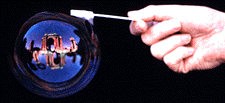Boys, C.V.
Soap Bubbles and the Forces Which Mould Them.
New York: Doubleday & Company, Inc.,1959.
Isenberg, Cyril.
The Science of Soap Film and Soap Bubbles.
Somerset, England: Woodspring Press Ltd., 1978
Lovett, David.
Demonstrating Science With Soap Films
Bristol & Philadelphia: Institute of Physics ISBN 0 7503 0269 0
Noddy, Tom.
Tom Noddy's Bubble Magic
Philadelphia, Pennsylvania: Running Press, 1988
Frederick J. Almgren, Jr. and Jean E. Taylor, 'The Geometry of Soap Films and Soap Bubbles' , Scientific American, July 1976, 82-93.
Jean T. Taylor,
'The structure of singularities in
soap-bubble-like and soap-film-like minimal surfaces'
, Annals of
Mathematics 103 (1976), 489-539
Frederick J. Almgren, Jr., 'Existence and regularity almost everywhere of solutions to elliptic variational problems with constraints' , Memoirs of the American Mathematical Society 165, 1975, viii + 199 pages. Better be a grad student in Mathematics for this paper!
Walker, Jearl.
'Amateur Scientist: Reflections on the rising bubbles in a bottle of beer"
Scientific American, December 1981.
Walker, Jearl.
'Amateur Scientist: What happens when water boils is a lot more complicated than vou might think."
Scientific American, December 1982.
Zubrowski, Bernie.
Bubbles: A Children's Museum Activity Book.
Boston: Little, Brown and Company, 1979.
Zubrowski, Bernie.
"Memoirs of a Bubble Blower."
Technology Retried, November December 1982.
Rogers, Eric M.
"Chapter Six - Surface Tension: Drops and Molecules" in Physics for an Inquiring Mind.
Princeton, New Jersey: Princeton University Press,1960.
Chapter Thirteen, Project Physics. New York: Holt, Rinehart and Winston,1970, 1975.
Bayrock, Fiona
"Bubble Homes and Fish Farts"
Charlesbridge Publishing, 2009. Illustrated by Carolyn Conahan
Pop up to bubbles contents |
